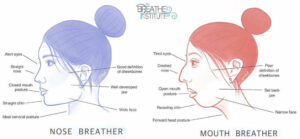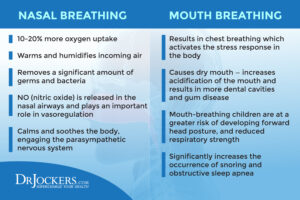Most of us will take approximately 20,000 breaths today, but never give those breaths a thought. Breathing is an automated function of the nervous system, but is complex and affects all parts of the body. When you breathe, you are using the body’s respiratory system to bring air into your lungs.
 Respiratory System
Respiratory System
The respiratory system is made up of the nose, mouth, throat, trachea (windpipe) and lungs. While the diaphragm is the main breathing muscle, the muscles surrounding the ribs, abdomen, neck and shoulders support your ability to breathe.
Since breathing is obviously crucial to our survival, let’s make sure we are doing it to the best of our ability. Regarding taking air into our lungs, we have 2 options: through the mouth or nose. Unfortunately, mouth breathing is common in today’s society and will lead to chronic overbreathing. It’s estimated that about 30-50% of adults breathe through their mouth, especially during sleep and earlier in the day.

Chronic Over-Breathing
Correct breathing has become extremely challenging in our modern society. We assume that the body reflexively knows how much air we need at all times, but our environment, filled with chronic stress, sedentary lifestyles, unhealthy diets and overall lack of fitness, has warped our perceived need for air. This, in turn, contributes to lethargy, weight gain, sleeping problems, respiratory conditions and heart disease. It might seem like getting more oxygen into our lungs is a good idea, but the reality is light breathing, through the nose, is in fact a testament to good health. For more information on chronic over-breathing, see Buteyko Method of Breathing.
To help determine if you are an over-breather, take this quiz and see how many “yes” answers you get:
- Do you sometimes breathe through your mouth as you go about your daily activities?
- Do you breathe through your mouth during your sleep? (side effects include a dry mouth, drool on your pillow)
- Do you snore or hold your breath during sleep? (sleep apnea)
- Can you visibly notice your breathing during rest? (does your breathing look and feel exaggerated or simple and quiet?)
- When you observe your breathing, do you see more movements from your chest than from your abdomen? (quiet relaxed breathing should come from your diaphragm and not from your chest)
- Do you regularly sigh throughout the day?
- Do you sometimes hear yourself breathing during rest?
- Do you experience symptoms resulting from habitual over-breathing, such as nasal congestion, fatigue, dizziness, or light-headedness?
Answering yes to some or all of these questions above suggests a tendency to over-breathe. These traits are typical of what happens when the amount of air we breathe is greater than what we need. Like water and food, there is an optimal amount of air we need to breathe each day. Just like eating too much can be damaging to our health, so can over-breathing. A simple and efficient way to control the amount of air we consume is to breathe through our nose.
Nose Breathing
Your nose is designed to help you breathe safely, efficiently, and properly. It can do this by its ability to:
- Filter out foreign particles. Nasal hair filters out dust, allergens, and pollen, which helps prevent them from entering your lungs.
- Humidify inhaled air. Your nose warms and moisturizes the air you breathe in. This brings the air you inhale to body temperature, making it easier for your lungs to use.
- Produce nitric oxide. During nasal breathing, your nose releases nitric oxide (NO). NO is a vasodilator, which means it helps to widen blood vessels. This can help improve oxygen circulation in your body.
Nasal breathing is much better for you. It can improve relaxation, reduce stress, improve circulation, and support restorative sleep. Proper nasal breathing throughout the day is, therefore, critical for your health and well-being.

Ways to Support Nose Breathing
- Practice! – Be mindful of your breathing strategy and focus on breathing through your nose at rest. The more you do it the easier it gets. For an easy strategy to improve your nose breathing see Breathing to Correct Posture & Alleviate Pain.
 Mouth Taping – Using a simple micropore surgical tape that covers your mouth will force you to breathe though your nose. This tape can be used when you sleep or even during light exercise to encourage nose breathing. Sometimes it takes a few nights sleep to get used to this, but it can really make nose breathing your automated normal breathing strategy.
Mouth Taping – Using a simple micropore surgical tape that covers your mouth will force you to breathe though your nose. This tape can be used when you sleep or even during light exercise to encourage nose breathing. Sometimes it takes a few nights sleep to get used to this, but it can really make nose breathing your automated normal breathing strategy.- Sinus Rinse – Many people have sinus congestion that causes a clogged nasal passageway. Using a Neti Pot can help relieve upper respiratory congestion and get you breathing through your nose more efficiently.
- Nebulizer – This is a simple device that produces a fine mist that you breathe in through your nose. I have been using a portable nebulizer, purchased on Amazon, that works very well and have been using a combination of filtered water, teaspoon of 3% hydrogen peroxide and a dropper full of colloidal silver. This has really helped clear out my nasal passageways and allows me to breathe freely through my nose. Check out the short demonstration video below:
The Buteyko Clinic website also has lots of resources to help you become a more efficient nose breather.
Hopefully this article has helped you see that your mouth is for eating and your nose is for breathing!
If you need help improving your health and fitness, please contact us at 310-534-1900 or info@backtofunction.com. At BTF, we help you FEEL – RECOVER – PERFORM – BETTER.
References:
How Many Breaths You Take Per Day & Why It Matters. Adventknows.com
Nasal Breathing: Benefits & How to Do It Properly. drjockers.com
McKeown, P. The Oxygen Advantage. 2015



